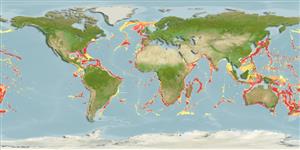Elasmobranchi (squali e razze) (sharks and rays) >
Carcharhiniformes (Ground sharks) >
Pseudotriakidae (False catsharks)
Etymology: Pseudotriakis: pseudo-, from pseudes (Gr.), false, i.e., although this genus may superficially resemble Triakis (Triakidae), such an appearance is false. (See ETYFish); microdon: micro-, from mikros (Gr.), small; odon (Gr.), tooth, referring to numerous small teeth (>200 rows in each jaw). (See ETYFish).
Environment: milieu / climate zone / depth range / distribution range
Ecologia
marino batidemersale; distribuzione batimetrica 173 - 1890 m (Ref. 58302). Deep-water; 64°N - 48°S, 98°W - 153°W
Western Atlantic: New York and New Jersey, USA. Reported from Cuba (Ref. 26340); including Brazil (Ref. 53443). Northeast Atlantic: Atlantic slope off Iceland, France, Portugal, Madeira, Azores, Senegal, and Cape Verde. Indian Ocean: Aldabra Island group and Western Australia (Ref. 13565). Pacific Ocean: Japan, Taiwan, New Zealand, and Hawaii (Ref. 13565).
Length at first maturity / Size / Peso / Age
Maturity: Lm 253.5, range 210 - 295 cm
Max length : 269 cm TL maschio/sesso non determinato; (Ref. 244); 295.0 cm TL (female)
Spine dorsali (totale) : 0; Spine anali: 0. Lower lobe of caudal fin hardly developed, its upper edge not rippled and a subterminal notch present (Ref. 13565). Uniformly dark brownish-grey, darker on posterior edges of pelvic, dorsal, anal and caudal fins (Ref. 13565).
Found on the continental and insular slopes, occasionally wandering onto continental shelves (Ref. 13565). Inactive and sluggish (Ref. 13565). Probably eats bony fishes, elasmobranchs and invertebrates (Ref. 244). Ovoviviparous, embryos feeding on yolk sac and other ova produced by the mother, uterine milk is consumed additionally (Ref. 50449). Pups number 2 to 4 in a litter (Ref. 244), size at birth between 70 (Ref. 244) and 140 cm TL (Ref. 13565). Caught very rarely by deepwater demersal longline fisheries in some areas. Utilized for its fins (limited value), meat and cartilage (Ref.58048).
Exhibit ovoviparity (aplacental viviparity), embryos feed on yolk and ova, also consume uterine milk (Ref. 50449) with 2-4 young in a litter (Ref. 13565; Ref.58048). Size at birth between 70 and 85 cm (Ref. 26346 reports it at about 140 cm TL). Distinct pairing with embrace (Ref. 205).
Compagno, L.J.V., 1984. FAO Species Catalogue. Vol. 4. Sharks of the world. An annotated and illustrated catalogue of shark species known to date. Part 2 - Carcharhiniformes. FAO Fish. Synop. 125(4/2):251-655. Rome: FAO. (Ref. 244)
IUCN Red List Status (Ref. 130435)
Threat to humans
Harmless
Human uses
Pesca: pesca di sussistenza
Strumenti
Special reports
Download XML
Fonti Internet
Estimates based on models
Preferred temperature (Ref.
123201): 4.8 - 12.7, mean 8.2 °C (based on 793 cells).
Phylogenetic diversity index (Ref.
82804): PD
50 = 1.0625 [Uniqueness, from 0.5 = low to 2.0 = high].
Bayesian length-weight: a=0.00047 (0.00023 - 0.00095), b=3.29 (3.10 - 3.48), in cm total length, based on LWR estimates for this species & (Sub)family-body (Ref.
93245).
Trophic level (Ref.
69278): 4.3 ±0.5 se; based on diet studies.
Resilienza (Ref.
120179): Molto basso, tempo minimo di raddoppiamento della popolazione più di 14 anni (K=0.17; Fec=2).
Fishing Vulnerability (Ref.
59153): Very high vulnerability (90 of 100).
